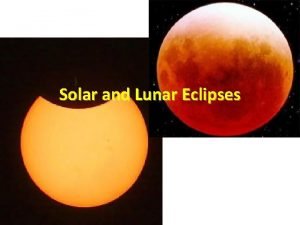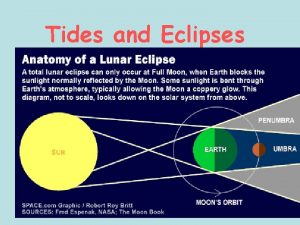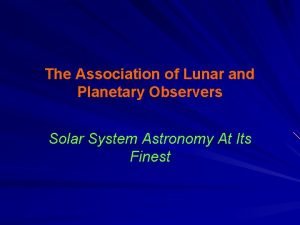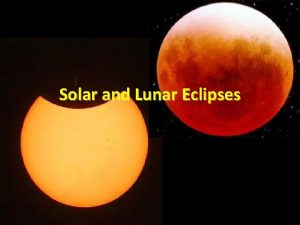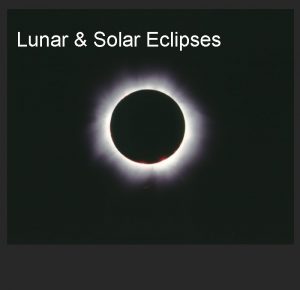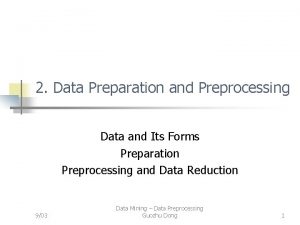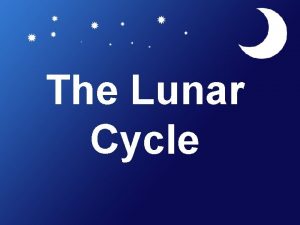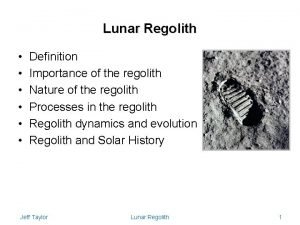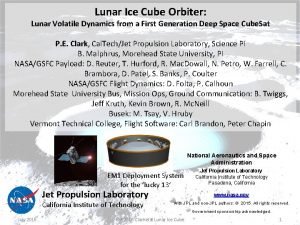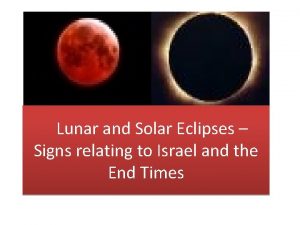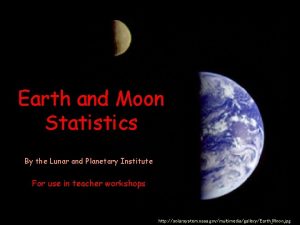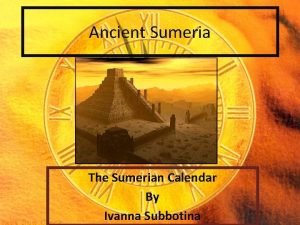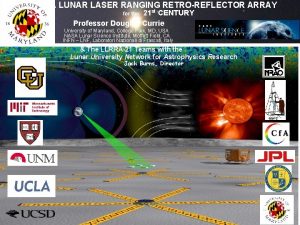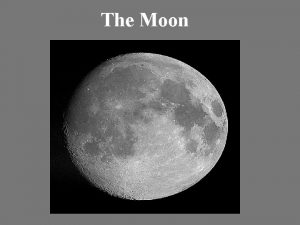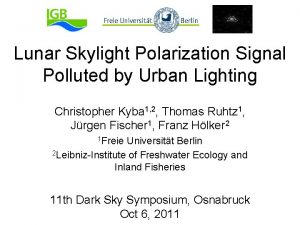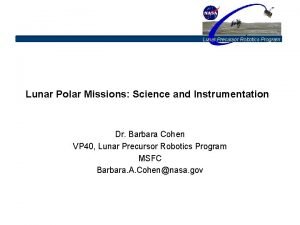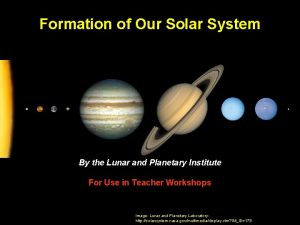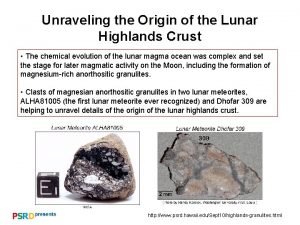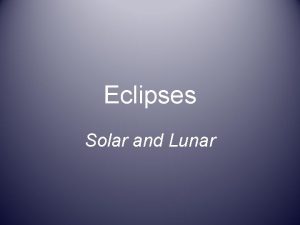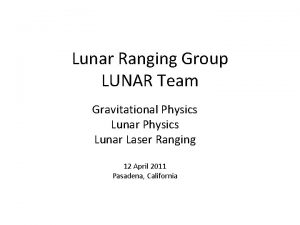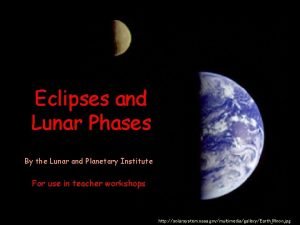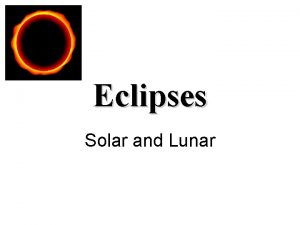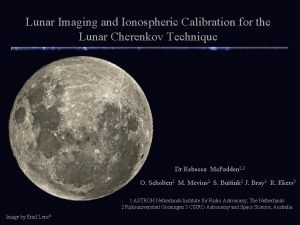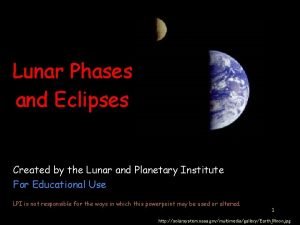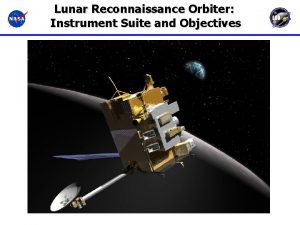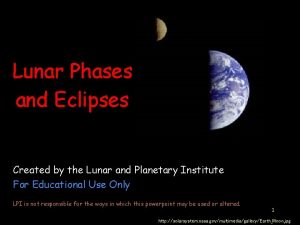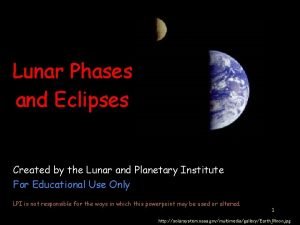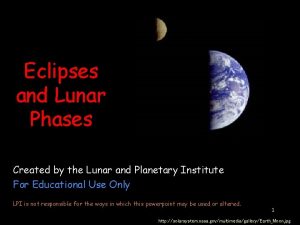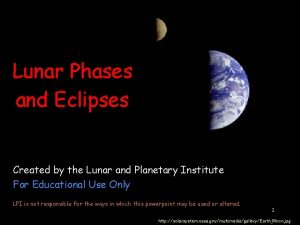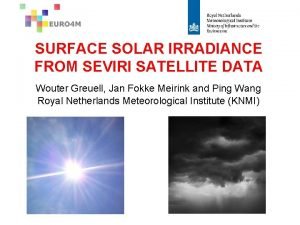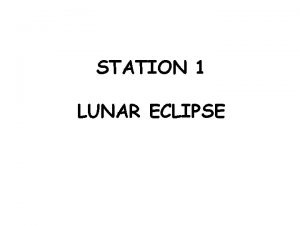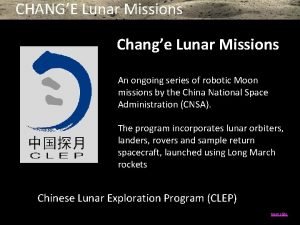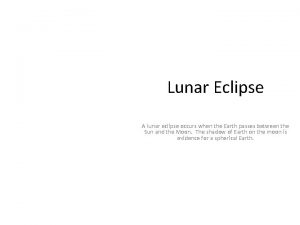Lunar Data Preparation for MVIRI and SEVIRI S





![Moon observations from EUMETSAT operating satellites: MSGs IR 087 observation clipped between [min(Im), max(Im)/5] Moon observations from EUMETSAT operating satellites: MSGs IR 087 observation clipped between [min(Im), max(Im)/5]](https://slidetodoc.com/presentation_image_h2/eb2af8b54bfbddd230f0dd352b4cd4d1/image-6.jpg)



![Moon observations from EUMETSAT operating satellites: MSGs IR 087 observation clipped between [min(Im), max(Im)/5] Moon observations from EUMETSAT operating satellites: MSGs IR 087 observation clipped between [min(Im), max(Im)/5]](https://slidetodoc.com/presentation_image_h2/eb2af8b54bfbddd230f0dd352b4cd4d1/image-10.jpg)


















- Slides: 28

Lunar Data Preparation for MVIRI and SEVIRI S. Wagner, B. Viticchie, T. Hewison Acknowledgement: T. Stone - USGS 1 Go to ‚View‘ menu and click on ‚Slide Master‘ to update this footer. Include DM reference, version number and date

Contents • Brief Description of the EUMETSAT operational satellites • Moon identification and extraction procedure • Calculation of the observables • Some results 2 Go to ‚View‘ menu and click on ‚Slide Master‘ to update this footer. Include DM reference, version number and date

EUMETSAT operating satellites 3 Satellite Time span Pixel resolution at SSP Bands VIS/NIR bands Service Meteosat-7 (MET 7) 1997 -2017 2. 5 km in VIS 5 km in WV and IR VIS (0. 3 -1. 05 µm) WV (5. 4 -7. 5 µm) IR (10. 0 -13. 1 µm) VIS 30 min repeat cycle VIS 006 (0. 6 µm) VIS 008 (0. 8 µm) HRVIS (0. 7 µm) NIR 016 (1. 6 µm) IR 039 (3. 9 µm) IR 062 (6. 2 µm) IR 073 (7. 3 µm) IR 097 (9. 7 µm) IR 108 (10. 8 µm) IR 120 (12. 0 µm) IR 134 (13. 4 µm) VIS 006 VIS 008 HRVIS NIR 016 Meteosat-8 (MSG 1) 2002 -present Meteosat-9 (MSG 2) 2005 -present Meteosat-10 (MSG 3) 2012 -present Meteosat-11 (MSG 4) 2015 -present [currently stored in orbit] 3 km low-res 1 km high-res Go to ‚View‘ menu and click on ‚Slide Master‘ to update this footer. Include DM reference, version number and date 18. 4 deg x 18. 4 deg FOR 15 min repeat cycle 18. 4 deg x 18. 4 deg FOR or 5 min cadence (RSS, reduced FOR centred on Europe)

EUMETSAT operating satellites Satellite Time span Pixel resolution at SSP Bands VIS/NIR bands Service Meteosat-7 (MET 7) 1997 -2017 2. 5 km in VIS 5 km in WV and IR VIS (0. 3 -1. 05 µm) WV (5. 4 -7. 5 µm) IR (10. 0 -13. 1 µm) VIS 30 min repeat cycle 18. 4 deg x 18. 4 deg FOR • All satellites are spin-stabilized GEO satellites with no dedicated observation of the Moon goes Meteosat-8 2002 -present 3 km low-res VIS 006 (0. 6 µm) VIS 006 15 min repeat across the FOR (MSG 1) 1 km high-res VIS 008 (0. 8 µm) VIS 008 cycle HRVIS (0. 7 µm) • Level 1. 0 raw data need to be checked since the. HRVIS Meteosat-9 2005 -present NIR 016 (1. 6 µm) NIR 016 18. 4 deg x operational image processing keeps only the Earth in (MSG 2) IR 039 (3. 9 µm) 18. 4 deg FOR IR 062 (6. 2 µm) Level 1. 5 (equivalent to Level 1 c). Meteosat-10 2012 -present (MSG 3) Meteosat-11 (MSG 4) 4 2015 -present [currently stored in orbit] IR 073 (7. 3 µm) IR 097 (9. 7 µm) IR 108 (10. 8 µm) IR 120 (12. 0 µm) IR 134 (13. 4 µm) Go to ‚View‘ menu and click on ‚Slide Master‘ to update this footer. Include DM reference, version number and date or 5 min cadence (RSS, reduced FOR centred on Europe)

EUMETSAT operating satellites Satellite Time span Pixel resolution at SSP Bands VIS/NIR bands Service Meteosat-7 (MET 7) 1997 -2017 2. 5 km in VIS 5 km in WV and IR VIS (0. 3 -1. 05 µm) WV (5. 4 -7. 5 µm) IR (10. 0 -13. 1 µm) VIS 30 min repeat cycle • Moon identification + extraction performed operationally 18. 4 deg x 18. 4 deg FOR with a time delay of 15 days. Meteosat-8 (MSG 1) • VIS 006 (0. 6 µm) VIS 006 15 min repeat VIS 008 a(0. 8 µm) VIS 008 For the data 2013 systematic analysis cycle HRVIS (0. 7 µm) HRVIS Meteosat-9 of 2005 -present the operational data archive. NIR 016 has been (1. 6 µm)performed NIR 016 to 18. 4 deg x (MSG 2) IR 039 (3. 9 µm) 18. 4 deg FOR look for the Moon. IR 062 (6. 2 µm) Meteosat-10 2012 -present IR 073 (7. 3 µm) or (MSG 3) (9. 7 instruments µm) • Offline processing required for IR 097 MVIRI prior IR 108 (10. 8 µm) 5 min Meteosat-11 2015 -present to Meteosat-7 IR 120 (12. 0 µm) cadence (RSS, (MSG 4) [currently IR 134 (13. 4 µm) reduced FOR stored in orbit] centred on Europe) 5 2002 -present 3 km low-res 1 km high-res acquired before Go to ‚View‘ menu and click on ‚Slide Master‘ to update this footer. Include DM reference, version number and date
![Moon observations from EUMETSAT operating satellites MSGs IR 087 observation clipped between minIm maxIm5 Moon observations from EUMETSAT operating satellites: MSGs IR 087 observation clipped between [min(Im), max(Im)/5]](https://slidetodoc.com/presentation_image_h2/eb2af8b54bfbddd230f0dd352b4cd4d1/image-6.jpg)
Moon observations from EUMETSAT operating satellites: MSGs IR 087 observation clipped between [min(Im), max(Im)/5] Step 1 – Spot the Earth : patch detection Define a two-level image with 1 where the Level 1. 0 pixel is above Space Count. IR 087 + Std_dev Space Count. IR 087 (from the Trailer) and 0 elsewhere. The two-level image has two patches at 1 (the Earth and the Moon) and one region at 0 (the deep-space). The largest one is (for sure) the Earth. Step 2 – Locate the off-Earth content of the image: removing the Earth From Step 1 one gets the Earth patch; what is out of this patch is considered the off-Earth content of the Level 1. 0 data (the Moon is in this part of the image). Step 3 – Spot the Moon Use the off-Earth content of the Level 1. 0 data to define a twolevel image with 1 where the Level 1. 0 pixel is above: Space Count. IR 087 + 3 x Std_dev Space Count. IR 087 (from the Trailer) and 0 elsewhere. The largest remaining patch is (for sure) the Moon, the other patches are residuals pixels. 6 Go to ‚View‘ menu and click on ‚Slide Master‘ to update this footer. Include DM reference, version number and date

Moon observations from EUMETSAT operating satellites: MSGs Knowing the relative position of the channels on the focal plane one can use the information obtained in the IR 087 to spot the Moon in the Solar Channels (VIS 006, VIS 008, NIR 016 and HRVIS) 7 Go to ‚View‘ menu and click on ‚Slide Master‘ to update this footer. Include DM reference, version number and date

Moon observations from EUMETSAT operating satellites: MSGs High-res observation and Moon detection Low-res observation and Moon detection 8 Go to ‚View‘ menu and click on ‚Slide Master‘ to update this footer. Include DM reference, version number and date

Moon observations from EUMETSAT operating satellites: MSGs Complication due to acquisition anomalies: strong jitter in Level 1. 0 data The shapes of both the Moon and the Earth are strongly affected by the anomaly, this can create problems in the identification and extraction! IR 087 observation clipped between [min(Im), max(Im)/5] affected by the high jitter 9 Go to ‚View‘ menu and click on ‚Slide Master‘ to update this footer. Include DM reference, version number and date
![Moon observations from EUMETSAT operating satellites MSGs IR 087 observation clipped between minIm maxIm5 Moon observations from EUMETSAT operating satellites: MSGs IR 087 observation clipped between [min(Im), max(Im)/5]](https://slidetodoc.com/presentation_image_h2/eb2af8b54bfbddd230f0dd352b4cd4d1/image-10.jpg)
Moon observations from EUMETSAT operating satellites: MSGs IR 087 observation clipped between [min(Im), max(Im)/5] after the correction by using the jitter files provided by the image processing 10 Go to ‚View‘ menu and click on ‚Slide Master‘ to update this footer. Include DM reference, version number and date

Moon observations from EUMETSAT operating satellites: MSGs Example of Level 1. 0 DC (raw) imagettes from MSG 1 VIS/NIR channels (corrected for the relative motion satellite-Moon) VIS 008 VIS 006 NIR 016 HRVIS A margin of 20 pixels is set around the moon 11 Go to ‚View‘ menu and click on ‚Slide Master‘ to update this footer. Include DM reference, version number and date

Moon observations from EUMETSAT operating satellites: MSGs The same procedure has been applied successfully to Meteosat 7 data by using the IR channel. VIS 008 as reference. NIR 016 (imagette not corrected VIS 006 for the relative motion satellite-Moon). VIS HRVIS Example of Level 1. 0 DC (raw) imagettes from MSG 1 VIS/NIR channels (corrected for the relative motion satellite-Moon) 12 Go to ‚View‘ menu and click on ‚Slide Master‘ to update this footer. Include DM reference, version number and date

Moon observations from EUMETSAT operating satellites Moon observations are available ONLY in Level 1. 0 data 13 Go to ‚View‘ menu and click on ‚Slide Master‘ to update this footer. Include DM reference, version number and date

Moon observations from EUMETSAT operating satellites: MSGs Moon observations are available ONLY in Level 1. 0 data Level 1. 0 DC raw imagette 14 Go to ‚View‘ menu and click on ‚Slide Master‘ to update this footer. Include DM reference, version number and date

Moon observations from EUMETSAT operating satellites: MSGs Moon observations are available ONLY in Level 1. 0 data Level 1. 0 DC raw imagette Equalization and non linearity correction (LUT) Process mimicking part of the image processing 15 Go to ‚View‘ menu and click on ‚Slide Master‘ to update this footer. Include DM reference, version number and date Level 1. 5 DC

Moon observations from EUMETSAT operating satellites: MSGs Moon observations are available ONLY in Level 1. 0 data Level 1. 0 DC raw imagette Equalization and non linearity correction (LUT) Process mimicking part of the image processing Level 1. 5 Radiance imagette 16 Calibration equation (linear) Go to ‚View‘ menu and click on ‚Slide Master‘ to update this footer. Include DM reference, version number and date Level 1. 5 DC

Moon observations from EUMETSAT operating satellites: MSGs Moon observations are available ONLY in Level 1. 0 data Level 1. 0 DC raw imagette Equalization and non linearity correction (LUT) Level 1. 5 DC For Meteosat 7 Process we usemimicking only Level part of 1. 0 DC imagettes. imageon processing We calibrated thethedata the ROLO/GIRO scale to estimate the instrument drift. Level 1. 5 Radiance imagette 17 No radiance Calibration imagettes are used. equation (linear) Go to ‚View‘ menu and click on ‚Slide Master‘ to update this footer. Include DM reference, version number and date

Calculation of the observables for the VIS/NIR bands at EUMETSAT 18 Go to ‚View‘ menu and click on ‚Slide Master‘ to update this footer. Include DM reference, version number and date

Computation of the digital count signal • Computation of the digital count signal and total number of pixels: integration over a mask on the illuminated portion of the Moon In the case of MVIRI, allowed us to reject some ghost signal seen away from the moon DC > Deep. Space_Threshold (idea = the instrument cannot make the difference between deep space and dark moon pixels) 19 Go to ‚View‘ menu and click on ‚Slide Master‘ to update this footer. Include DM reference, version number and date

Computation of the irradiance 20 Go to ‚View‘ menu and click on ‚Slide Master‘ to update this footer. Include DM reference, version number and date

Calculation of the offset and calibration on the ROLO/GIRO scale • Mean value of the digital counts contained in the margin around the Moon (currently 5 pixel-wide margin) Imposing 21 leads to: Go to ‚View‘ menu and click on ‚Slide Master‘ to update this footer. Include DM reference, version number and date

Some additional info • Meteosat platform = spin-stabilized platforms spin velocity is monitored and is stable • Scan is “parallel” to the displacement of the Moon in the FOR (it will not be the case for MTG/FCI). • Ghost effect only observed for MVIRI, away from the lunar disc effect removed with the integration method • Coordinates of the satellite = provided by the Level 1. 5 header • Acquisition time = calculated using the On-Board-Time for the line where the Moon centre is located and correcting for the position • Each line of detectors (3 in the Low Res) is acquired in less than 1. 6 seconds. • Uncertainty assessment still to be done… 22 Go to ‚View‘ menu and click on ‚Slide Master‘ to update this footer. Include DM reference, version number and date

Some (old) results to illustrate… MSG 2/VIS 006 time variation of the irradiance bias: Calibration coefficients updated in time: monitoring of the instrument + calibration combined (no trend clearly visible) 23 Go to ‚View‘ menu and click on ‚Slide Master‘ to update this footer. Include DM reference, version number and date

Some (old) results to illustrate… MSG 1/NIR 016 time variation of the irradiance bias: Phase dependence of the irradiance bias 24 Go to ‚View‘ menu and click on ‚Slide Master‘ to update this footer. Include DM reference, version number and date

Some (old) results to illustrate… MSG 2/VIS 006 time variation of the irradiance bias: Calibration coefficient at the ROLO scale: monitoring of the detector THE TREND IS CLEARLY VISIBLE 25 Go to ‚View‘ menu and click on ‚Slide Master‘ to update this footer. Include DM reference, version number and date

Some results to illustrate… Example: monitoring of the VIS 0. 8 channel of MSG 2. IMPORTANT CONCLUSION: SEVIRI CHANNELS BEHAVE AS EXPECTED (AS REQUIRED). True for all platforms! 26 Go to ‚View‘ menu and click on ‚Slide Master‘ to update this footer. Include DM reference, version number and date

Example of drift monitoring, using the ROLO scale: Meteosat-7 27 Go to ‚View‘ menu and click on ‚Slide Master‘ to update this footer. Include DM reference, version number and date

Conclusions EUMETSAT Moon observation dataset: • Meteosat-7, Meteosat-8, Meteosat-9, Meteosat-10 and Meteosat-11. • Extensive collection of observations covering a wide range of both phase and libration angles covering the full applicability range of the GIRO ([-92°, 92°]). • Lunar imagery is operational performed on all operational missions (Meteosat -8, Meteosat-9, Meteosat-10 and soon Meteosat-11 again). GIRO calibration: The GIRO calibration tool is run operationally to monitor the satellite radiometric performances. 28 Go to ‚View‘ menu and click on ‚Slide Master‘ to update this footer. Include DM reference, version number and date
 Data preparation and basic data analysis
Data preparation and basic data analysis Markku roiha
Markku roiha Difference between solar and lunar eclipse
Difference between solar and lunar eclipse Differentiate between lunar eclipse and solar eclipse
Differentiate between lunar eclipse and solar eclipse What type of tide occurs at a lunar and solar eclipse?
What type of tide occurs at a lunar and solar eclipse? Association of lunar and planetary observers
Association of lunar and planetary observers What is an eclipse
What is an eclipse Exo solar lunar
Exo solar lunar Data preparation and preprocessing
Data preparation and preprocessing Waning crescent tattoo
Waning crescent tattoo Regolith def
Regolith def Lunar ice cube
Lunar ice cube Lunar eclipse israel
Lunar eclipse israel Moon stats
Moon stats Pontaj lunar
Pontaj lunar Carl sagan lunar eclipse
Carl sagan lunar eclipse Ancient sumerian calendar
Ancient sumerian calendar Lunar laser ranging retroreflector array
Lunar laser ranging retroreflector array Whats a natural satellite
Whats a natural satellite Busek bit-3
Busek bit-3 300 solar years to lunar years
300 solar years to lunar years Heart
Heart Chris ruhtz youtube
Chris ruhtz youtube Lunar precursor robotic program
Lunar precursor robotic program Lunar 1996
Lunar 1996 Lunar new year jeopardy
Lunar new year jeopardy Lunar legend festival riddles
Lunar legend festival riddles Lunar
Lunar Lunar
Lunar



